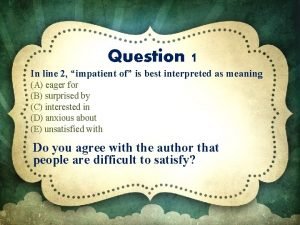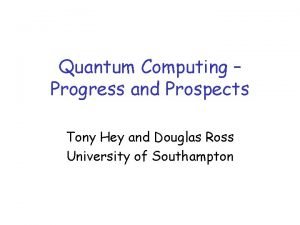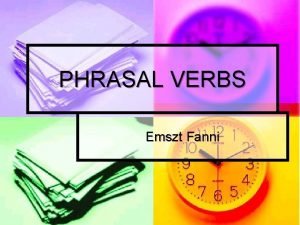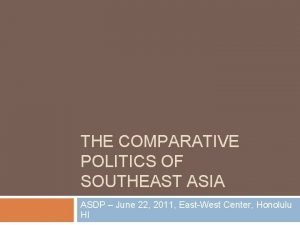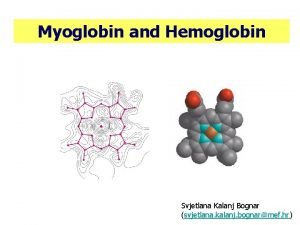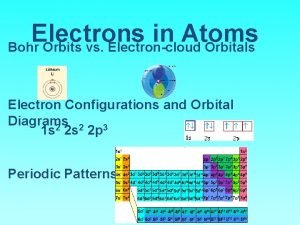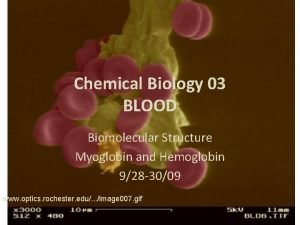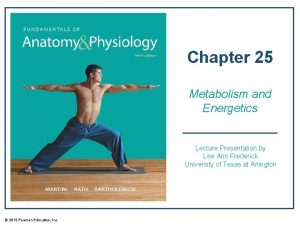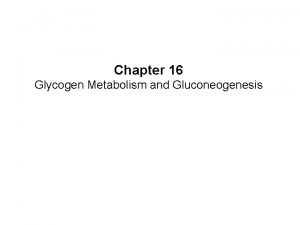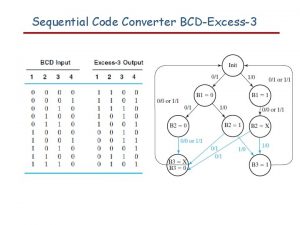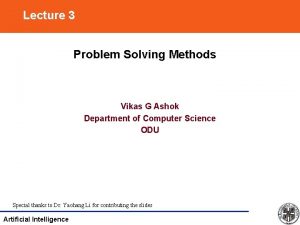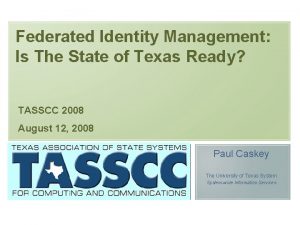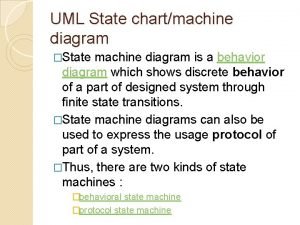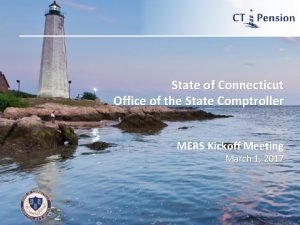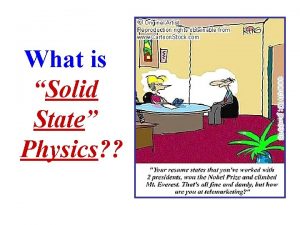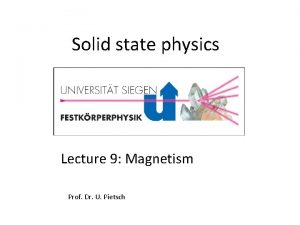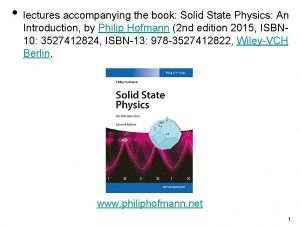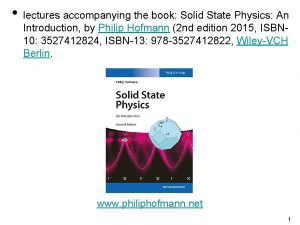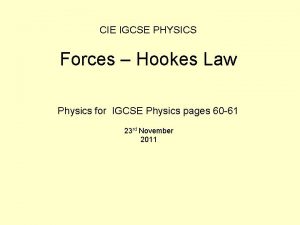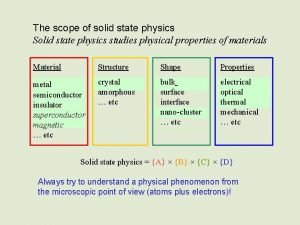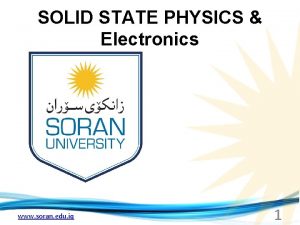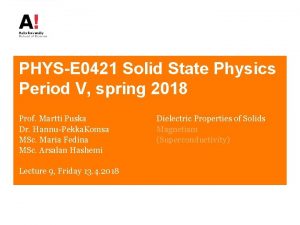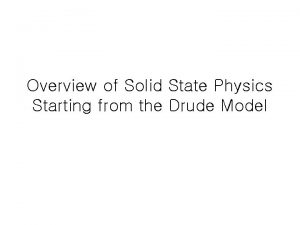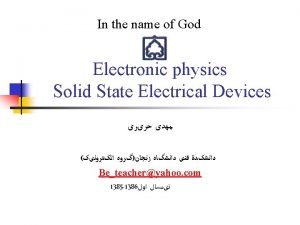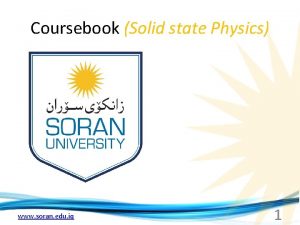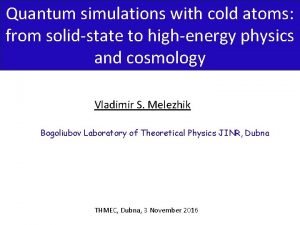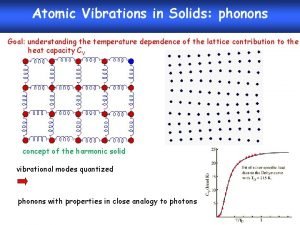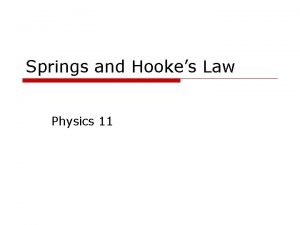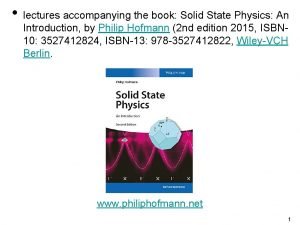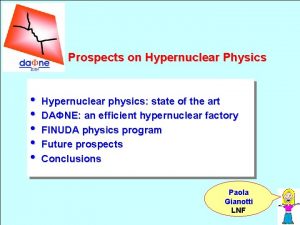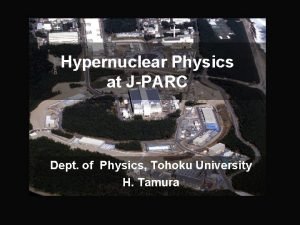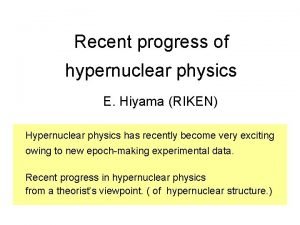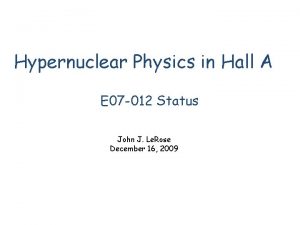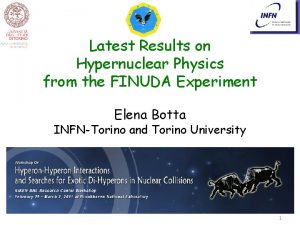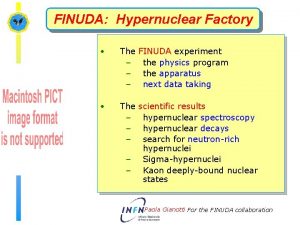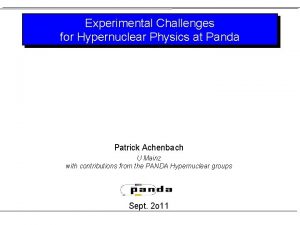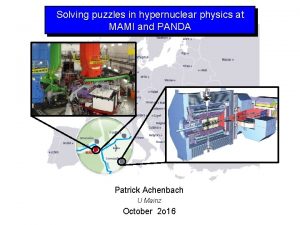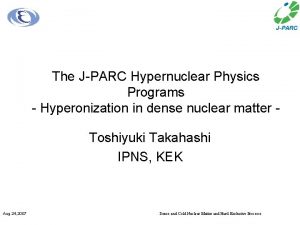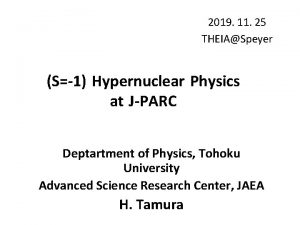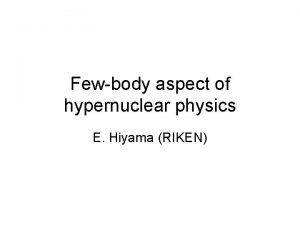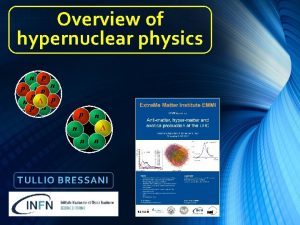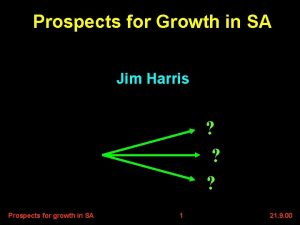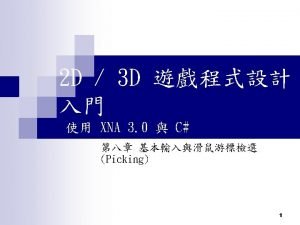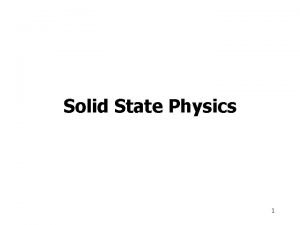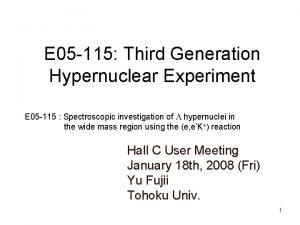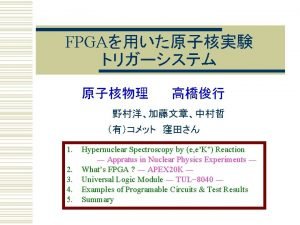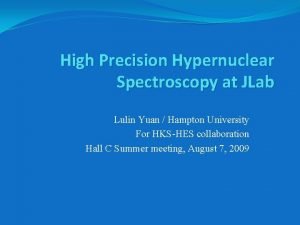Prospects on Hypernuclear Physics Hypernuclear physics state of


























![FINUDA first run : October 2003 – March 2004 Daily integrated luminosity [nbarn-1] nb-1 FINUDA first run : October 2003 – March 2004 Daily integrated luminosity [nbarn-1] nb-1](https://slidetodoc.com/presentation_image/377c49f0bf12b3b8a670404887f7ec89/image-27.jpg)













- Slides: 40

Prospects on Hypernuclear Physics • • • Hypernuclear physics: state of the art DAΦNE: an efficient hypernuclear factory FINUDA physics program Future prospects Conclusions Paola Gianotti LNF

Hypernuclear Physics: state of the art Hypernuclear physics is a good tool to match nuclear and particle (r) physics. The study of this field may help in understanding some crucial questions: four baryon weak interaction vertex; (r) w, h p d u u u s N p N N d W d u d n K N N YN and YY strong interactions; N change of hyperon and meson properties in the nuclear medium; existence of di-baryon particles; the role played by the quark degrees of freedom, a d + a 6 Li flavor symmetry and chiral models in nuclear and hypernuclear field. d

50 years of Hypernuclear Physics The 1 st round 1953 Discovery of Λ hypernuclei Emulsion detectors --- CERN PS, BNL AGS K- beam Λ potential depth about 1/2 The 2 nd round First Counter Experiments CERN & BNL 1973 Stopped (K-, π-) at CERN 1974 in-flight (K-, π-) at CERN PS and BNL AGS very small spin-orbit splitting The 3 rd round New reactions with New Detectors 1985 (π+, K+) started at AGS 1990 S=-2 searches at AGS and KEK (Emulsion-counter hybrid technique) 1993 S=-1 Λ Spectroscopy, Weak decay, SKS spectrometer 1998 g ray spectroscopy (Hyperball) ΛN potential definition Γn/ Γp puzzle in the non-mesonic decays

Production of Λ-Hypernuclei Different production mechanisms can be used to form an hypernuclei: strangeness exchange reaction (in flight, stopped) σ ≈ 100 mb ; Ibeam = 104 s-1 associated production σ ≈ 1 mb ; Ibeam = 107 s-1 real and virtual photo- production Hyperon recoil momentum [Me. V/c] σ ≈ μb ; Ibeam = 1010 s-1 θL= 0 o Projectile momentum p. Lab [Ge. V/c]

Production of Λ-Hypernuclei (K+, π+), and (K-stop, π-) are similar, both DWIA calculations give to the hyperon a large momentum transferred, but not identical. Many excited a 12 C(K-, π-) hypernuclear states p. K=800 Me. V/c Saclay-Lyon amplitude 12 C(g, K+)12 B Λ Eg=1. 1 Ge. V b θ=10 o c 12 C(π+, K+) pπ=1040 Me. V/c θ=0 o -) 12 C(Kstop, π T. S. H. Lee et al. , Phys. Rev. C 58 (1998) 1551. Electroproduction mainly populates streched and unnatural parity nuclear states. K. Itonaga et al. , Prog. Theor. Phys 84 (1990) 291.

Production of Λ-Hypernuclei exp. results sΛ 12 C(g, K+)12 pΛ ΛB 12 C(K-, π-) pΛ sΛ HNSS(E 89 -009) high resolution (900 Me. V FWHM) spectrometer FINUDA experiment high resolution (1. 4 Me. V FWHM) spectometer

Hypernuclear Spectroscopy • GOAL: GOAL understanding Baryon-Baryon interactions • NN interaction: experimentally well known from elastic scattering data phenomenologically well reproduced by meson-exchange and quark-cluster models • YN, YY interaction: poor scattering data low yield, short lifetime (c t < 10 cm) information from hypernuclei are important mostly Λ-hypernuclei ΛN interaction In Λ-hypernuclei: No Pauli effect, weak coupling simple structure extraction of ΛN interaction is rather straightforward

Hypernuclear Spectroscopy Text book le-pa e rticle xample of orbit s in nucl eu Sing s Hotchi et al. , PRC 64 (2001) 044302 The peak positions is well described by a Wood-Saxon potential Phenomenological NN, YN potential, mainly based on OBE mechanism, improves (Nijmegen ESC 02, 03) thanks to hypernuclear physics

Recent improvements (1998~2003) g spectroscopy 7 Li, 9 Be, 10 B, 11 B, 15 N, 16 O 13 C D KEK E 419, E 509, E 518; BNL E 930 BNL E 929 Hyperball Na. I array SL p shell: 4 radial integrals for p. N, sΛ w. f. SN T

Towards hyper-fine splitting understanding N- LS interaction SN~ -0. 4 Me. V KEK E 419 (π+, K+) 7ΛLi BNL E 930 (K-, π-) 9ΛBe BNL E 929 (K-, π-) 13ΛC spin-spin interaction D = 0. 50 Me. V HYPERBALL SL= - 0. 01 Me. V SL = 152 ± 54(stat) ± 36(syst) ke. V Na. I The experimental measurements on SΛ are in agreement but smaller than the values given by the meson exchange models BNL E 930 (K-, π-) 13ΛC T ~ 30 ke. V (prelim. ) First info. on T OBEP predictions agree with the experimental value ND NF NSC 89 NSC 97 f T (ke. V) 18 33 36 54

ΛΛ interaction • Unique channel in SU(3) BB interaction classification • Repulsive core may vanish in this channel possibile existense of H-dibaryon (uuddss, J=I=0) • Original prediction by Jaffe (PRL 38 (1977) 195) - H is predicted 80 Me. V below ΛΛ mass • No experimental evidence so far - at least, deeply bound H is rejected • ΛΛ - Ξ N (- ΣΣ) coupling important (ΔE = 28 Me. V) • ΛΛ interaction study performed by - ΛΛ hypernuclei - ΛΛ final state interaction in (K-, K+) reaction (J. K. Ahn et al. , PLB 444 (1998) 267 ) • Present data suggests ΛΛ interaction is weakly attractive

Hybrid emulsion experiment (KEK-PS E 373) K- K+ • Hybrid emulsion -- (K-, K+) reaction to produce Ξ then stop it in emulsion • The best event found (H. Takahashi et al. , PRL 87(2001)212502) 6 • Track #1 is the He 6 • Binding energy of He is obtained to be B = 7. 3± 0. 3 Me. V (from a+2 ) • In order to extract interaction, we take DB = B - 2 B ( 5 He) = 1. 0± 0. 3 Me. V weakly attractive

Chain of π- decays (BNL E 906) D 6 line CDS detector: (K-, K+) Ξ - , Ξ - + 9 Be -> ΛΛ Z + X First production of ΛΛ hypernuclei by a counter experiment 4 ΛΛ H → 4 ΛHe* + π- (104) → 3Λ H + p → 3 He + π- (114. 3) 3 4 PRL 87(2001) 132504 LH LLH 4 3 LH LH

A new branch of nuclear physics is studyng light nuclei with extended spatial distribution giving rise to a neutron halo. Better candidates to study matter with extreme N/Z ratio are neutron rich Λ-hypernuclei 7ΛH, 6ΛH, 12ΛBe, . . . number of protons Neutron rich Λ-Hypernuclei Superheavy elements Proton-rich nuclei solar burning Neutron-rich nuclei number of neutrons Here more extended mass distribution are expected thanks to the “gluing role” of the Λ Interesting also for astrophysics studies on high density nuclear matter in neutron stars

Neutron rich Λ-Hypernuclei Tretyakova et al. , Nucl. Phys, A 691 (2001) 351 c, Akaishi et al. , Frascati Phys. S. XVI, (1999) 59 Two different production mechanisms have been invoked: 1. Double charge exchange K- p → Λ π0 ; π0 p → n π+ π -p → π 0 n ; π 0 p → K + Λ • Strangeness exchange with Λ-Σ coupling K- p → Σ- π+ ; (Σ- n Λ p) π-p → Σ- K+ ; (Σ- n Λ p) 10 B KEK E 521 FINUDA

Weak decay of hypernuclei • In free space. . . Λ p + π- (63. 9%, Q = 38 Me. V) n + π0 (35. 8%, Q = 41 Me. V) • ΔI=1/2 rule holds - initial state: I=0, final state: I=1/2 or 3/2 if If = 1/2, branch is 2: 1 3/2, 1: 2 - this is a general rule in strangeness decay, but no one knows why • This decay (called mesonic decay) is suppressed in hypernuclei due to Pauli blocking for the final state nucleon. • Therefore, non-mesonic decay occurs in hypernuclei p + Λ p + n, n + Λ n + n, . . - Is the ΔI=1/2 still valid? We need to measure Γn and Γp

Weak decay of hypernuclei observables: mesonic decay OPE 0. 05 0. 2 Γn / Γ p 0 non- mesonic decay OME (with heavy meson ) Quark models … 0. 5 1 1. 5 Exp. Value 0. 5 2 Do we need quarks to describe non-mesonic decay or the OBE description is good?

Experimental measurements (past) Past experiments only measured Γtot asymmetry of the weak decay of polarized Hypernuclei Λ lifetime is almost constant for A > 10 non-mesonic decay dominate short range nature of non-mesonic decay

Experimental measurements (present) Modern experiments can measure En+Ep Γp and Γn at the same time: KEK SKS FINUDA First results are coming from KEK 5 LHe En+En (E 462) : Γn/ Γp 0. 45± 0. 11± 0. 03 systematic error : neutron efficiency(6%) + acceptance (3%) To be compared with the old data: 0. 93± 0. 55 (Szymanski et al. PRC 43 (1991)849) Is the puzzle of Γn/ Γp solved? Stay tuned. .

FINUDA FIsica NUcleare a DAΦNE The Φ provide a unique “K- beam” : 1. monochromatic low momentum (127 Me. V/c) 2. trigger tagging K-stop event through the associate K+ 3. no hadronic background that can be stopped in thin targets to produce hypernuclei K-stop + AZ A Z Λ +π-

FINUDA scientific program 6 Li • source of Λ 4 He and Λ 5 He ( Λ 6 Li unstable) to study of the decay of light hypernuclei 7 Li • comparison with the 6 Li; available data of poor quality

12 C • reference target for spectroscopy and weak decay studies • expected over 105 events in the excitation spectrum • search for weakly excited states, ≤ 10 -5/Kstop (present limit 10 -4/Kstop) • weak decays: Γp (Λp → n p) Γn (Λn → n n) Γpn (Λ n p → n n p) New Γnn (Λ n n → n n n) New Γ π - ( Λ → p π -) 27 Al • never studied before • measurement of the capture rate in medium A hypernuclei 51 V • no measurements available with K- at rest, useful for weak decay studies • important to assess the capture rate for medium and heavy A hypernuclei

DAΦNE Complex energy 510 Me. V Design Luminosity 5 1032 cm-2 s-1 X(rms) 2. 11 mm y(rms) 0. 021 mm z(rms) 35 mm Bunch length 30 mm Crossing angle 13 mrad Frequency (max) 368. 25 MHz Bunch/ring Up to 120 Part. /bunch 8. 9 1010 Current/ring 5. 2 A (max) r o t ra le e c x e l Ac p m Co KLOE FINUDA

FINUDA Detector TOFONE detector Magnet end-cap Magnet yoke B=1. 0 T Mechanical support (clessidra) Straw tubes, LMDC, Vertex/target

FINUDA Interaction Region Targets Carbon target profile 4. 70 0. 03 2 mm Sci. 44. 10 1. 70 0. 03 210. 00 26. 0 44. 10 200. 00 2. 60 27. 10 3. 70 244. 00 1. 00 Be 500μm 27. 10 2. 60 244. 00 Lithium target profiles 0. 60 4. 70 27. 10 3. 325 0. 03 0. 625 200. 00 210. 00 1. 00 2. 60 44. 10 200. 00 Vanadium target profile 44. 10 3. 7 0. 03 210. 00 2. 60 44. 10 Aluminum target profile 3 12 C 1 51 V 1 27 Al 2 6 Li 1 7 Li

![FINUDA first run October 2003 March 2004 Daily integrated luminosity nbarn1 nb1 FINUDA first run : October 2003 – March 2004 Daily integrated luminosity [nbarn-1] nb-1](https://slidetodoc.com/presentation_image/377c49f0bf12b3b8a670404887f7ec89/image-27.jpg)
FINUDA first run : October 2003 – March 2004 Daily integrated luminosity [nbarn-1] nb-1 FINUDA Integrated luminosity [nbarn-1] pb-1 FINUDA Integratedluminosity deliveredto to. FINUDA 30∙ 106 events recorded From 14 -Oct- 2003 to 22 -Mar-2004 DAΦNE delivered 250 pb-1 to IP 2 33 pb-1 machine tuning 10 pb-1 FINUDA debugging 190 pb-1 useful data taking DAΦNE peak luminosiy (cm-2 s-1)

FINUDA Detector performances • S. C. Solenoid: B = 1. 0 T field homogeneity within 2% • Interaction/Target region: selection of K+- K- pairs , production and detection of hypernuclei. z = 30 m ; en. res. 20% FWHM • External tracking device: trajectories and momenta of charged particles with high precision Δp/p = 0. 3%. VDET z resolution LMDC: (r, f) 150 m; z 1% wire length ST: (r, f) 150 m; sz = 500 m • External scintillator barrel: trigger purposes and neutron detection (10% eff. , 8 Me. V en. Resol. ) • Helium gas chamber: reduction of particle multiple scattering. FINUDA momentum resolution Dp/p is: 0. 3% in He 1. 5% in air Pid in VDET Outer TOF time resolution

Distribution of stopped KReconstructed K- stopping points – external layer: 8 targets – inner layer: microstrip ISIM modules 6 Li ISIM 2 12 C 7 Li ISIM 1 Φ 12 C ISIM 8 K- stopping in ISIM are about 10% of the total due to a boost (≈ 13 Me. V) of the Φ in the x direction 12 C ISIM 7 51 V e+ 27 Al 12. 5 mrad Φ e-

Experimental results π- spectra coming form different target materials π-spectrum contributions Clean hypernuclear structures can be seen in any target material Λ - hyp

Looking for protons from the Non-Mesonic Λ decay all positive from K- vertex 12 C target -1. 8<BΛ<11. Me. V Particles coming from background processes can be easily rejected requiring: d. E/dx in the proton region; pπ- >240 Me. V/c

FINUDA future prospects @ L = 1033 cm-2 s-1 FINUDA can observe ~ 1. 6 · 103 ev/h from YN g. s. Ø machine duty cycle: 75% Ø spectrometer acceptance: 72% Ø Ge acceptance: ~ 30% Ø εGe: ~ 30% ~ 1. 87 · 103 ev/d The Segmented Clover Detector BGO Compton suppression shield active collimator (scintillator) Ge crystals Geometrical acceptance reduced to 72%

Conclusions Hypernuclear Physics has reached the status of a science mature It helps in understanding BB weak and strong force allowing a detailed study into a SU(3) flavor symmetry environment Some open problems still remain: precise measurements of the spin-observables; double Lambda hyp. binding force B; Existence of neutron rich hypernuclei; Survey on different targets of Γn /Γp.

Future activities • Jlab Hall A (HRS), Hall C (HKS) • DAΦNE FINUDA → DAΦNE 2 with g spect. • KEK-PS, BNL-AGS (E 930, E 963, E 964) SKS, Hyperball 2, . . • J-PARC ・ Ξ hyp. Spectroscoy using K-K+ reaction ・ ΛΛ hyp. Study using π- seq. decay • GSI PANDA ΛΛ hyp. Ge spectroscopy


Bhabha events e+ e- e+ e - e + e Ks + - ee+ r 0 + - e+ e- invariant mass (Ge. V/c)

Ks + - events - + Ks +

Hypernuclear typical event + K- F K+ +

Momentum resolution K+ μ+ νμ , π+πo K+ + (236 Me. V/c) Δp/p 0. 9% K+ + o (205 Me. V/c) From the width of the μ+ the spectrometer momentum resolution is evaluated. After mechanical alignment Δp/p 0. 4%

Background contributions TOT K- p + K- n 0 - K- p - + - n - K- n - p - K- (NN) - N - n -
 The principal contrast in the passage is between
The principal contrast in the passage is between Quantum computing: progress and prospects
Quantum computing: progress and prospects Prospects of agriculture in bangladesh
Prospects of agriculture in bangladesh World population prospects
World population prospects Prospects preposition
Prospects preposition Properties of liquid state of matter
Properties of liquid state of matter State to state regionalism
State to state regionalism Sr flip flop truth table
Sr flip flop truth table Software implementation of state graph
Software implementation of state graph T and r state of hemoglobin
T and r state of hemoglobin What is the difference between an orbital and a shell
What is the difference between an orbital and a shell T state vs r state
T state vs r state Absorptive state and postabsorptive state
Absorptive state and postabsorptive state Glycogen regulation
Glycogen regulation Age of consent state by state
Age of consent state by state Salesforce 101: introduction to salesforce kurs
Salesforce 101: introduction to salesforce kurs State diagram to state table converter
State diagram to state table converter Duncker diagram example
Duncker diagram example State state graphs and transition testing
State state graphs and transition testing What is initial state + goal state in search terminology?
What is initial state + goal state in search terminology? Tasscc state of the state
Tasscc state of the state Behavioral state machine diagram
Behavioral state machine diagram State of connecticut office of the state comptroller
State of connecticut office of the state comptroller Solid physics
Solid physics Magnetism in solid state physics
Magnetism in solid state physics Philip hofmann solid state physics
Philip hofmann solid state physics Philip hofmann solid state physics
Philip hofmann solid state physics State hooke's law in physics
State hooke's law in physics What is hooke's law igcse
What is hooke's law igcse Scope of solid state physics
Scope of solid state physics Polycrystalline solids
Polycrystalline solids Solid state physics
Solid state physics Solid state physics
Solid state physics Drude model solid state physics
Drude model solid state physics Quantum number l meaning
Quantum number l meaning Physics
Physics Simulations for solid state physics
Simulations for solid state physics Michigan state university physics department
Michigan state university physics department Understanding solid state physics
Understanding solid state physics State hooke's law in physics
State hooke's law in physics Philip hofmann solid state physics
Philip hofmann solid state physics
